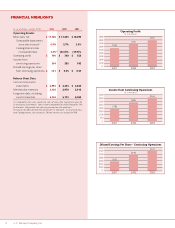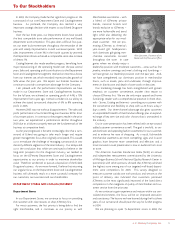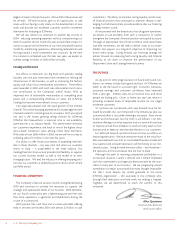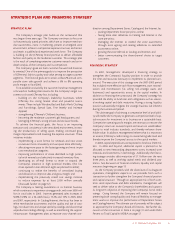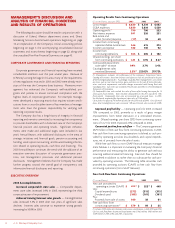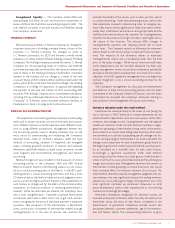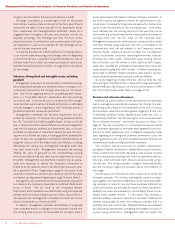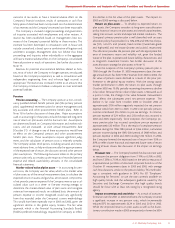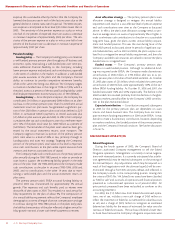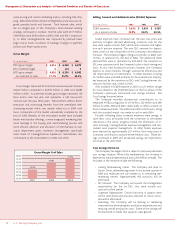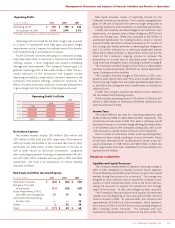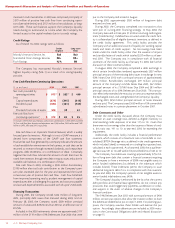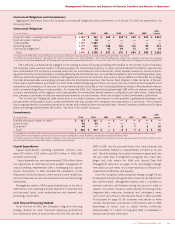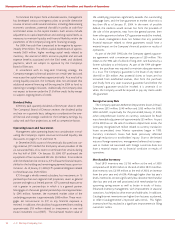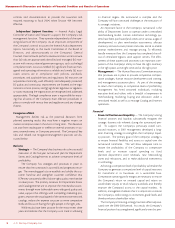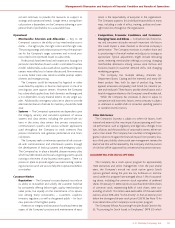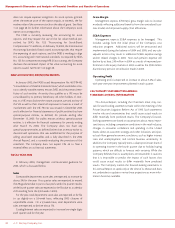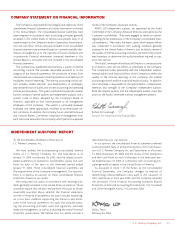JCPenney 2003 Annual Report Download - page 14
Download and view the complete annual report
Please find page 14 of the 2003 JCPenney annual report below. You can navigate through the pages in the report by either clicking on the pages listed below, or by using the keyword search tool below to find specific information within the annual report.
J. C. Penney Company, Inc.12
Management’s Discussion and Analysis of Financial Condition and Results of Operations
value pricing and certain marketing events, including free ship-
ping. Sales reflected less reliance on Big Books and a focus on tar-
geted specialty books and Internet. Total Internet sales, which
are an integral part of the Company’s three-channel retailing
strategy, continued to increase. Internet sales were $617 million,
$409 million and $349 million in 2003, 2002 and 2001, respective-
ly. In 2002, Catalog/Internet was impacted by planned lower
page counts, lower circulation of catalogs, changes to payment
policies and fewer outlet stores.
Gross Margin
($ in millions) 2003 2002 2001
FIFO gross margin $6,614 $6,340 $ 6,073
LIFO credit/(charge) 6(6) 9
LIFO gross margin $6,620 $6,334 $ 6,082
As a percent of sales 37.2% 35.9% 33.6%
Gross margin improved for the third consecutive year and was
$6,620 million compared to $6,334 million in 2002 and $6,082
million in 2001. As a percent of sales, gross margin improved 130
basis points over last year and represents a 540 basis-point
increase over the past three years. Improvement reflects better
execution and continuing benefits from the centralized mer-
chandising model, which was initially rolled out in 2000, with
most components of the model substantially complete by the
end of 2003. Benefits of the centralized model have included
better merchandise offerings, a more integrated marketing plan,
more leverage in the buying and merchandising process and
more efficient selection and allocation of merchandise to indi-
vidual department stores. Inventory management, specifically
lower levels of Catalog/Internet liquidation merchandise, also
contributed to the improvement in 2002 over 2001.
Selling, General and Administrative (SG&A) Expenses
($ in millions) 2003 2002 2001
SG&A expenses $5,830 $5,634 $ 5,529
As a percent of sales 32.8% 32.0% 30.5%
SG&A expenses have increased over the past two years due
primarily to higher planned advertising, transition costs for the
new store support center (SSC) distribution network and higher
non-cash pension expense. The new SSC network for depart-
ment stores is a key component of the Company’s centralization
initiative. The Company began rolling out the SSCs in 2002, with
10 SSCs in operation by the end of 2002. The additional three
planned SSCs were in operation by mid-2003. The transition to
SSCs was consistent with the Company’s plan in both timing and
costs. As this new distribution process matures, the Company
expects to attain benefits through operational efficiencies and
the improved flow of merchandise. In 2002, expenses totaling
$17 million were recorded primarily for the severance for employ-
ees impacted by the transition to SSCs and Catalog/Internet dis-
tribution facilities that closed in 2003.
Also included in SG&A expense in 2003 is a $21 million charge
for costs related to the implementation of the first phase of the
Company’s previously announced cost savings initiative. See
Cost Savings Initiative below.
The Company recorded discretionary contributions to its
employee 401(k) savings plan of $19 million, $20 million and $48
million for 2003, 2002 and 2001, respectively, to reflect a match at
more competitive levels. The additional 2003 contribution, along
with the standard match, was made in cash in early 2004.
Partially offsetting these increased expenses were savings in
store labor costs, principally from the conversion to centralized
checkouts in the stores, progress toward the elimination of in-
store receiving, Catalog/Internet expense management and cen-
tralized store expense management. In 2002, SG&A expenses
were reduced by approximately $27 million from reductions in
Company contributions toward retiree medical costs. These sav-
ings continued in 2003 and annualized savings are expected to
continue at the same level.
Cost Savings Initiative
The Company has begun the first steps of a previously disclosed
cost savings initiative. When fully implemented, this initiative is
expected to reduce expenses by at least $200 million annually. The
first steps of the initiative include the following:
•Catalog Telemarketing Center: The Company will close its
Austin, Texas, telemarketing center in the second quarter of
2004 and reallocate the call volume to its remaining tele-
marketing centers. Approximately 450 positions will be
eliminated.
•SSC Network: The Company will assume the management
responsibility for the six SSCs that were initially out-
sourced to third parties.
•Corporate Organization: Certain functions in support areas
will be centralized, and resources devoted to certain activi-
ties will be eliminated.
•Marketing: The Company will be refining its marketing
investment by eliminating less productive expenditures and
reducing overall production costs. Some of the savings will
be reinvested in media that supports sales growth.
Gross Margin % of Sales
38.0%
37.0%
36.0%
35.0%
34.0%
33.0%
32.0%
31.0%
33.6%
35.9%
37.2%
2001 2002 2003


